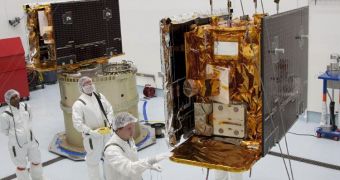Engineers in Florida carried out final tests and assessments on the twin GRAIL spacecraft that NASA built for lunar exploration. The probes are now ready for take off, and launch is scheduled to take place about a month from now.
The mission is dubbed the Gravity Recovery and Interior Laboratory (GRAIL), and features two identical vehicles whose jobs will be to collect in-depth data on the Moon's gravitational pull.
At this time, the American space agency plans to launch both spacecraft on September 8, when a window of opportunity will be opened from 5:37 am PDT (1237 GMT) to 6:16 am PDT (1316 GMT).
GRAIL-A and GRAIL-B were put together at the Titusvill, Flroida-based Astrotech Space Operations facility. On Tuesday, August 9, they were subjected to a final inspection and weight test, after which time they were cleared for transfer to their launch pad.
An United Launch Alliance (ULA) Delta II Heavy rocket has been selected as the delivery system for moving the spacecraft to Earth's orbit. Launch will occur from Launch Complex 17, at the Cape Canaveral Air Force Station (CCAFS).
NASA has from September 8 to October 19 to launch the GRAIL vehicles. Once in lunar orbit, the two spacecraft will enter a flight formation that will enable them to analyze the entire inner structure of the Moon, from its core to the outer layers of its crust.
By the end of this week, both GRAIL-A and GRAIL-B will be mated with a special adapter, and then inserted into their protective payload fairing. The entire ensemble will be mated to the delivery system after it is moved to the SLC-17 next week.
“GRAIL-A and GRAIL-B will fly in tandem orbits around the moon for several months to measure its gravity field in unprecedented detail,” a press release from experts at the NASA Jet Propulsion Laboratory (JPL) explains.
“The mission will answer longstanding questions about Earth's moon, and provide scientists a better understanding of how Earth and other rocky planets in the solar system formed,” the team adds. The JPL group is managing the mission for the NASA Science Mission Directorate in Washington DC.
The principal investigator of the GRAIL mission, expert Maria Zuber, is based at the Massachusetts Institute of Technology (MIT), in Cambridge. She will work very closely with the JPL team for conducting the most relevant studies GRAIL is capable of.

 14 DAY TRIAL //
14 DAY TRIAL //